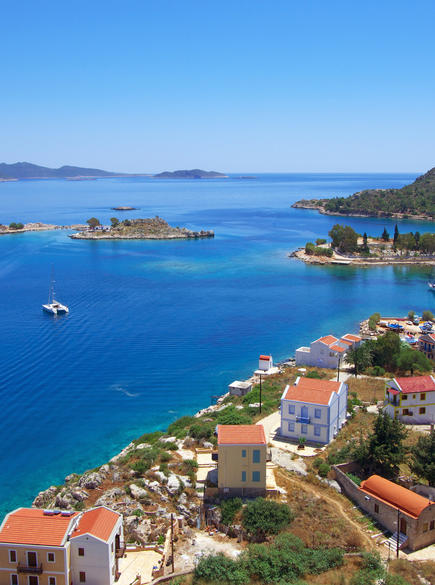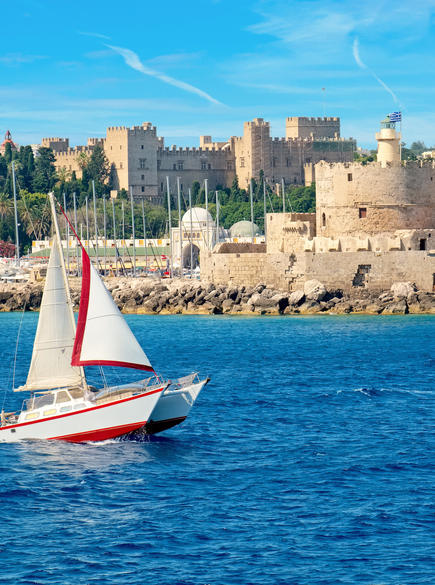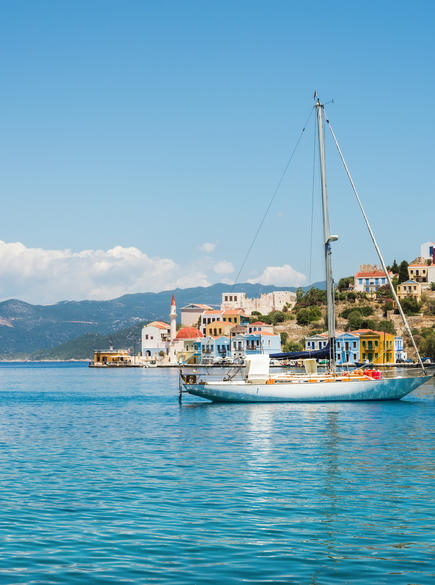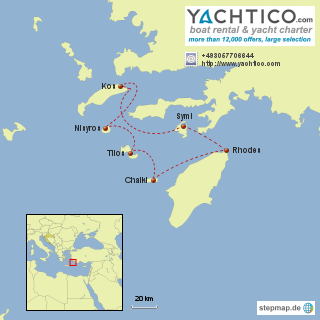Sailing the Dodecanese Islands

Boats for rent in: Dodecanese
Sailing Adventure in the Dodecanese - Discover Dodecanese Islands
In the area of the Dodecanese the strong wind Meltemi blows. Beginners and families recommended to sail in the transitional periods.
- Moderate infrastructure
- High winds
- Many bays
- Season: March to October
- Mediterranean climate


Sailing Hot-Spots in the Dodecanese
The Dodecanese, an enchanting group of islands in the southeastern Aegean Sea, offers some of the best sailing areas in Greece. Each island presents unique characteristics, making the region a paradise for sailors.
Rhodes: Known as the largest of the Dodecanese islands, Rhodes is famous for its historical sites, vibrant nightlife, and beautiful beaches. The island's advanced marinas and facilities make it a preferred starting point for many sailing trips.
Kos: Situated near the Turkish coast, Kos is renowned for its lively marinas, cosmopolitan atmosphere, and historical landmarks. It's a hub for sailors looking to explore nearby islands or the Turkish coastline.
Leros: Known for its natural harbors and calm waters, Leros is excellent for sailors who prefer a relaxed sailing atmosphere. The island is less crowded than Rhodes or Kos, offering a more authentic Greek island experience.
Symi: Symi is celebrated for its picturesque harbor and neoclassical architecture. The island’s sheltered bays provide excellent mooring spots, making it a favorite for day trips from Rhodes.

Sailing Conditions
During the summer months, the Meltemi wind has a pleasant and cooling effect. he Meltemi typically comes from the west and averages around 4 on the Beaufort scale (Bft), which indicates moderate winds. In the peak of the summer, however, the strength of the Meltemi can escalate significantly, reaching up to 8 Bft. This increase in wind strength can catch sailors off guard, making navigation challenging. For sailing crews with less experience, the combination of strong north winds and active wave conditions can be particularly challenging and may require cautious navigation. Alongside the wind, the sea conditions in the Dodecanese can be influenced heavily by the Meltemi. Stronger winds lead to higher waves, which need skillful handling. South of Karpathos area is noteworthy as the Meltemi can blow consistently at strengths between 5 to 7 Bft for several weeks. Such conditions are ideal for wind surfing but can be demanding for regular sailing.
Moorings, Marinas and Harbours
Many harbors in the Dodecanese retain a traditional Greek island feel, offering a blend of natural beauty and cultural experiences. Some harbors can become very crowded during the peak summer months, so advance planning or reservations might be necessary.
Major Harbors and Marinas
Rhodes Marina: Located on the island of Rhodes, this marina is a modern facility equipped with high-end amenities. It's well-protected from winds and offers easy access to the historic city of Rhodes.
Kos Marina: Situated on the island of Kos, this marina is known for its excellent facilities and services. It's close to the island's main attractions and provides a good shelter from the Meltemi winds.
Mandraki Harbor, Rhodes: Steeped in history and located near the old town, Mandraki is a picturesque harbor but can be quite busy during peak season.
Leros Marina: Located in Lakki Bay on Leros, this is a well-sheltered marina offering a peaceful environment with good facilities.
Popular Moorings
Symi Harbor: A charming and bustling harbor, popular for its picturesque setting and traditional architecture. It offers good mooring spots, although it can get crowded.
Patmos Skala Harbor: Known for its crystal-clear waters and proximity to the historic Monastery of Saint John, it's a favorite among sailors for both short-term and overnight stays.
Kalymnos Harbor: Popular among climbers and sailors alike, this harbor provides good anchorage and is close to the island’s famous climbing spots.

Sailing Routes Dodecanese
Sail the impossibly clear waters of the Dodecanese in Greece, and reach idyllic harbors and pebbled beaches on the diverse islands. Rhodes is the center of the Dodecanese, and has a plethora of boats available for charter. Rhodes Town is an impressive medieval walled town where the Colossus of Rhodes, one of the 7 ancient wonders of the world once stood. From here we suggest sailing to the small island of Symi..
How to get there - Airports in Dodecanese
- Athens International airport Eleftherios Venizelos
- Alexandros Papadiamantis international airport
- Kos International airport "Hippocrates“
- Naxos island national airport
- Rhodos International airport
- Samos International airport - "Aristarchos of Samos"
- Santorini (Thira) Island National Airport
- Syros Island National airport
Climate & Weather in Dodecanese
The Dodecanese experiences a Mediterranean climate. The summer is long and the sailing season begins in March. In the months of July and August temperatures rise well above 30 °C, but relatively low humidity and a cooling breeze makes the heat bearable. From May to September there is usually little rain. Even in late autumn, temperatures rarely drop below 20 °C. Given the variability and potential strength of the Meltemi, thorough planning and preparation are crucial for safe navigation in the Dodecanese. Sailors need to be aware of weather forecasts and plan their routes accordingly.